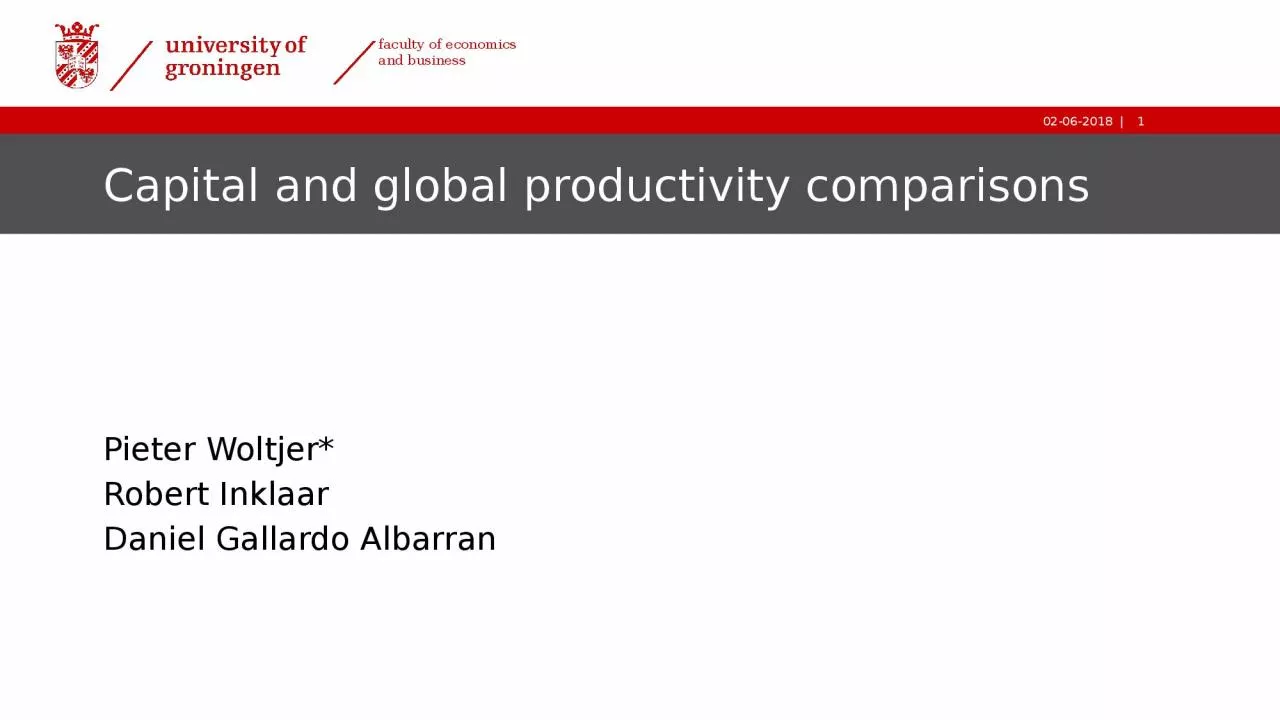

productivity comparisons Pieter Woltjer Robert Inklaar Daniel Gallardo Albarran Background and objectives Development Accounting Proximate Causes Physical Capital Human Capital TFP Maddison ID: 1026864
Download Presentation The PPT/PDF document "Capital and global" is the property of its rightful owner. Permission is granted to download and print the materials on this web site for personal, non-commercial use only, and to display it on your personal computer provided you do not modify the materials and that you retain all copyright notices contained in the materials. By downloading content from our website, you accept the terms of this agreement.
1. Capital and global productivity comparisonsPieter Woltjer*Robert InklaarDaniel Gallardo Albarran
2. Background and objectives Development AccountingProximate Causes Physical Capital, Human Capital, TFP (Maddison)Role of inputs in accounting for income differences across countriesCurrent state of debate:Physical Capital accounts 10-20% income differencesTFP accounts 50-70%
3. Limited role physical capital?Weakness in development accountingCapital assumed to be homogenous unitLessons from growth accounting:Different assets have different user costs and marginal productsI.e. for an identical stock value, a Computer will generally add more to output than a Building (in a single year)Capital service measure will give greater weight short-lived assetsassets with rapidly falling pricesboth characteristics will drive up cost to hire the asset
4. Update to Penn World TableNew estimates of starting stocks of capital3 methods: PIM, t*, average38 countries: long-run investment series <190092 countries: investment series >1950 & <197077 countries: investment series >1970Estimates of physical capitalCapital stocksCapital services
5. Starting stocks: PIMPWT 9.01950: Assume Capital/Output (K/Y) ratio of 2.6PWT 9.138 countries historical investment (I) series from <1900Use Perpetual Investment Method (PIM) to estimate Capital Stock (K) in 1950
6. Starting stocks: PIM
7. Starting stocks: t*PWT 9.01950-…: Assume Capital/Output (K/Y) ratio of 2.6PWT 9.192 countries investment from 1950/1970 onwardsUse (arbitrary) K/Y ratio for first year (t0)Lower bound: 0.5Upper bound: 4.0Define t* as year that lower and upper bound convergeExtrapolate K/Y at t* back to t0
8. Example of t* estimate starting K/Y
9. Example of t* estimate starting K/Y
10. Time trend in K/Y ratioLinear regression model ky ~ 1 + year + countrycode Estimated Coefficients: Estimate SE tStat pValue _______ _______ _____ ___________ (Intercept) -32.429 0.93232 -34.8 4.118e-215 year 0.018 0.00047 37.5 5.9051e-243 Number of observations: 2445, Error degrees of freedom: 2406Root Mean Squared Error: 0.432R-squared: 0.701, Adjusted R-Squared 0.697F-statistic vs. constant model: 149, p-value = 0
11. Example of t* estimate starting K/Y
12. K/Y ratios: new estimates
13. TFP: PWT 9.0 vs 9.1 (Capital Stocks)
14. Capital Services (1)As opposed to capital stocks, which measure the total value, or wealth of all capital equipment and structures in place, our measure captures the capital service flows derived from these capital assets.Capital services weight the growth of capital assets by their respective rental prices, whereas capital stocks weight assets by their asset price.
15. Capital ServicesUser Cost of Capital (UCC) reflects the fact that in equilibrium, an investor is indifferent between two alternatives: either buying a unit of capital at time t-1, collecting a rental fee and then selling the depreciated asset in the next period, or earning a nominal rate of return on a different investment opportunity.The UCC thus depend on the asset-specific depreciation rates (), the rate of return () and the capital gains or losses from price changes in an alternative investment ().
16. Median UCC by asset
17. TFP: PWT 9.0 vs 9.1 (Capital Services)
18. Development Accounting:Contributions of capital, labor and TFP (in 2011)